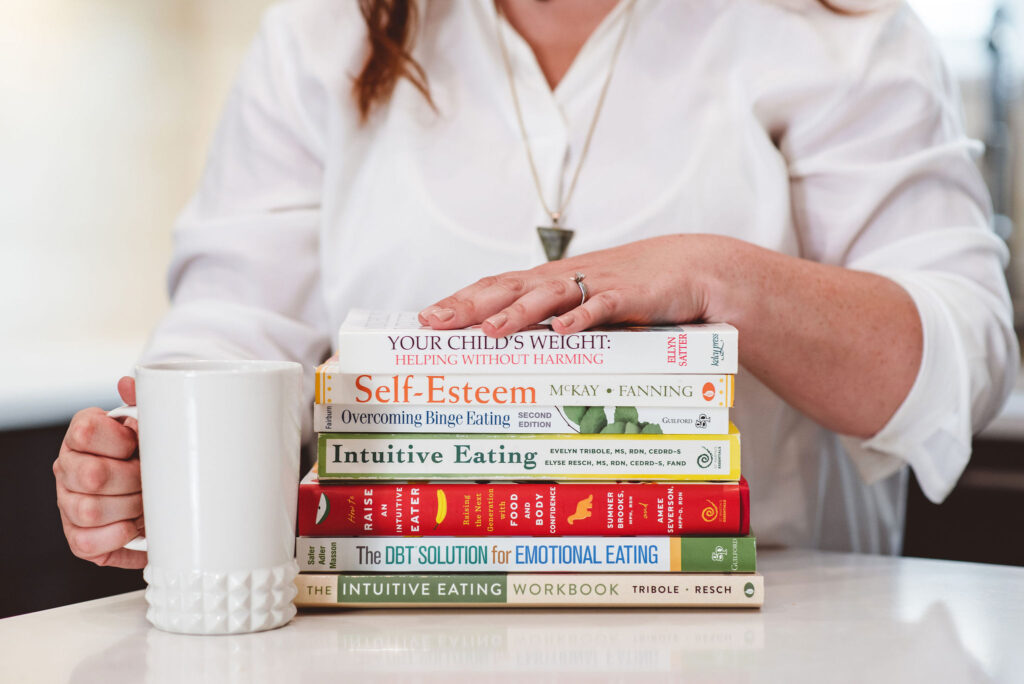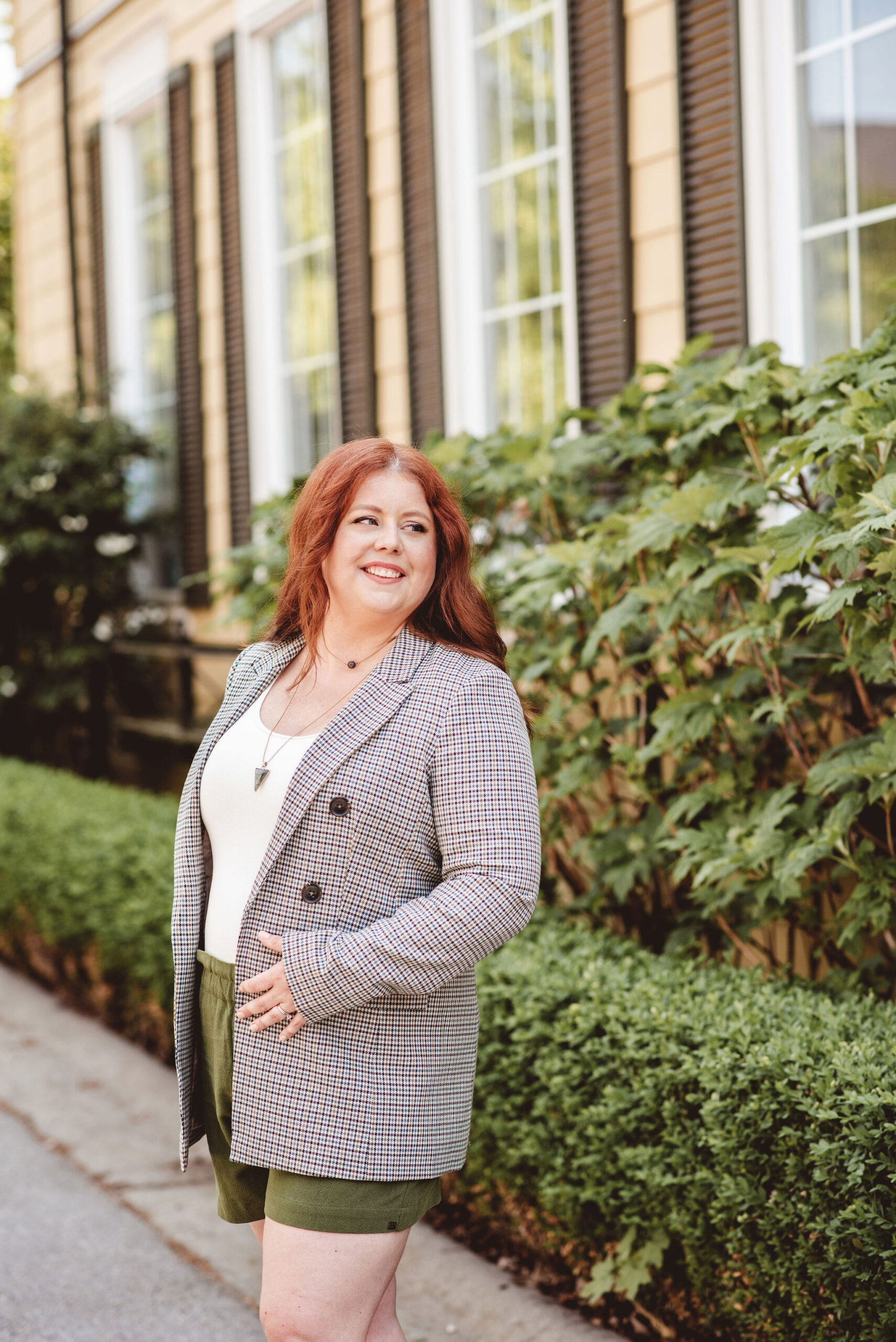If you’re here wondering what to do after a binge, please know this: you are not alone, and you are not broken. Maybe you feel stuffed, ashamed, or overwhelmed. Maybe your mind is already racing with plans to skip your next meal or start fresh tomorrow.
But before you go down that path, take a breath.
This guide is here to help you care for yourself after a binge. Not to punish or fix you, but to support you with kindness. Healing from binge eating isn’t about being perfect. It’s about learning to meet yourself with compassion, even in the messy moments.
Hi, I’m Meredith MacKenzie, a binge eating therapist, intuitive eating coach, and founder of the One Body To Love program. I support women who feel stuck in the binge-restrict cycle and are ready for a kinder way forward with food. If you’ve ever asked yourself what to do after a binge or felt overwhelmed by shame and self-criticism, you’re not alone. For daily support, real talk, and gentle tools to heal your relationship with food and body, come join me on Instagram.
Before we jump into the steps, watch this short video where I walk you through each one with care. It’s a supportive place to start.
Step 1: What to Do After a Binge — Pause and Breathe
The first thing to do after a binge is to pause. Not to punish yourself. Not to plan your next diet. Just pause.
Take a deep breath. Then another. Feel your feet on the ground or your hands on your lap. This helps your nervous system calm down, especially if you’re feeling panicked or ashamed.
You don’t need to rush into fixing anything. Nothing is broken. Right now, your only job is to come back to the present moment. Breathing slowly and gently helps remind your body that you are safe.
This simple pause can be the start of a new pattern. One that begins not with self-blame, but with care.
Step 2: Name What’s Happening Without Judgment
After a binge, it’s easy for your inner critic to take over. Thoughts like “I blew it” or “What’s wrong with me?” might start flooding in. But what if you could simply name what happened, without making it mean something bad about you?
Try saying to yourself, “I had a binge.” That’s it. Not “I failed,” not “I’m out of control.” Just a clear, honest statement.
This helps you separate the binge from your identity. You are not your eating patterns. You are a human being who had a hard moment. Naming it clearly, without shame, is a powerful act of self-respect.
The more you practice this kind of gentle honesty, the more space you create for healing.

Step 3: What to Do After a Binge — Gently Reconnect with Your Body
After a binge, you might feel disconnected from your body. Maybe you feel too full, numb, or checked out. That’s okay. Reconnecting doesn’t have to be big or dramatic. It can be quiet and simple.
Here are a few gentle ways to come back to your body:
- Place a hand on your belly or chest. Feel the rise and fall of your breath.
- Sip some water slowly. Let it be soothing, not a way to “flush” or fix.
- Stretch your arms or legs. Just enough to feel a small shift.
- Lie down and feel the ground beneath you. Let your body be supported.
- Step outside for a minute. Feel the air on your skin.
None of these are about making up for the binge. They are about reminding your body that it is worthy of care, even now. You don’t have to feel fully “back” right away. Reconnection can be slow. Let it come at your pace.
Step 4: Reflect with Curiosity, Not Criticism
Once you feel a bit more grounded, you might notice the urge to figure out why the binge happened. That’s a natural part of healing. But the way you reflect matters.
Instead of asking, “What’s wrong with me?” try asking:
- What was I feeling before the binge?
- Had I eaten enough earlier in the day?
- Was I overwhelmed, tired, or lonely?
- Did I feel like I had to be perfect with food?
These questions aren’t meant to blame you. They’re here to help you understand your patterns with kindness. Every binge has a story. Curiosity helps you hear it. Criticism shuts it down.
The goal is not to find a perfect answer. It’s to start noticing what your body and emotions might be trying to tell you. This is how you learn. This is how trust begins to grow.
If body image feels like one of the biggest barriers to healing your relationship with food, you are not alone. In this blog post, I share the top three body image struggles my clients face and how we begin to work through them with compassion and care.

Step 5: Normalize Eating at the Next Meal
After a binge, it can feel tempting to skip your next meal or try to eat as little as possible. This is a common reaction, especially if you feel guilty or uncomfortable. But restricting after a binge often keeps the cycle going.
Your body still needs nourishment. Even if you ate a lot earlier, your next meal is not a punishment or a test. It is an important step toward building a healthy relationship with food. This helps your body learn that it will be fed consistently and that food is not being taken away.
Try to offer yourself a balanced, satisfying meal when you’re ready. Something you’d normally eat. Something that feels kind. This helps your body feel safe again. It tells your system, “I’ve got you. You’re going to be fed.”
Eating normally after a binge might feel strange at first. But it’s a powerful way to break the binge-restrict cycle and move toward peace with food.
Ready for more peaceful evenings? Grab my free guide, 5 Steps to End Night Binge Eating. This gentle resource will help you break the nighttime binge cycle and create a calming routine that supports true rest and care.
Step 6: Reaffirm Your Healing Path
After a binge, it’s easy to feel like you’ve failed or lost all your progress. But one binge doesn’t erase your growth. Healing from binge eating is not a straight line. It’s a process, and it includes hard moments like this.
Take a moment to remind yourself of what you’re working toward. Maybe it’s food freedom. Or it’s a more peaceful relationship with your body. Maybe it’s the ability to eat without fear or guilt.
Whatever your goal is, it’s still within reach. One binge does not define your journey. You are still on the path.
You might say something to yourself like, “This is part of learning,” or “I can care for myself even when it’s hard.” These small affirmations can make a big difference.
You don’t have to start over. You just keep going, gently and with care.
For more support after a binge, this video offers a compassionate breakdown of what to do next and why it matters for your healing:
What to Do After a Binge: A Kind Way Forward
Knowing what to do after a binge is not about having the perfect response. It is about learning to meet yourself with softness instead of shame. Each step you take, from pausing to reconnecting, from reflecting to nourishing, helps you rebuild trust with your body and your inner world.
Perfection is not required. What matters is taking the next kind step, and then the one after that. Hard days will come, and you are still allowed to keep moving forward.
There is nothing wrong with you. Healing is already happening, one moment at a time. And even in the hardest moments, you are never alone.
If you’ve just had a binge and feel stuck in shame or self-blame, please know you don’t have to figure this out alone. In my small group coaching program, One Body To Love, you’ll find a compassionate space to break free from the binge-restrict cycle, understand what’s driving your eating patterns, and reconnect with your body without guilt or pressure.
If you’re craving more personalized support, my 1:1 coaching offers a safe, non-judgmental space to explore your relationship with food and body on a deeper level. We work together to gently uncover what’s beneath the binges and help you move toward lasting peace. If you’re curious about what support might be right for you, I’d love to connect, book a free discovery call today.
Looking for more support right now? Check out my YouTube channel for free videos on binge eating recovery and intuitive eating, or listen to my podcast, One Body To Love, for honest conversations and tools to guide your healing journey.
